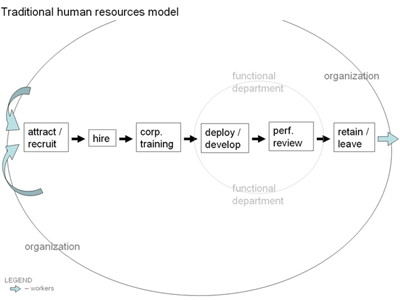|
|
 |
| Source: Fixing HR: An Economic Analysis of 30 Thought Leaders' Best Practices + Detailed Blueprint for the New Economy |
The single most frustrating thing to a vendor is being the unfortunate owner of a rolodex that's only good a few months. As any salesperson with feet on the street knows, re-orgs and lay-offs are the primers of "shifted priorities", and more upsetting than not being on a prospect's radar anymore is losing track of the prospect altogether because they're no longer doing what they did just the week prior. So, you're left with two choices, both exercisable simultaneously: start another futile effort to court, schmooze, and dine another easily corruptible 20-something or overly bitter 40-something while waiting for the rotated exec you previous courted and bonded with to get into another position where your merchandise becomes attractive again. A million motivational speakers, sales trainers, and personal coaching gurus later, and you're finally ready to stop selling to become a senior executive on the client side.
As we all know, consultants are often behind the decisions that invariably make the life of most mid-level managers miserable. In an effort to earn our keep by making a recommendation, (regrettably, sometimes any recommendation), we advise media clients to revamp a department or business unit for optimal performance. However, as is often the case, during the execution, politics flair up, egos are bruised, and clients play what amounts to a game of musical chairs with their personnel in the hopes that it'll shake off the "leeches" (actually the most experienced and most willing to mentor junior executives at the company) and breathe some "fresh air" into a failing (but in mid-level management's view, strong) infrastructure. That, in turn, causes similar re-alignments at marketing services firms. And that, in turn, explains the abysmal rates of churn, morale, and loyalty in the marketing business (not that any actually matter, as big advertising holding companies have still been able to make billions without any of them).
To be sure, consultants' recommendations take into consideration not just one area of the company at one point in time, but the entire organization moving forward. A mid-level manager's inability to see past their own cubicle isn't a consultant's fault and if the client's own loyalty programs and morale were already deficient to begin with, it makes matters worse. Re-orgs, right-sizes, and their variously named cousins all require a goal, detailed planning, and perfect execution, any of which done sloppily can morph the process into a process akin to an overly enthusiastic IRS audit. At a presentation to a large media concern, the interactive marketing executive not only dozed off regularly, but asked her intern to sit in so she can continue snoozing while we trained him with our presentation! Cutting that waste of time short, I subsequently proceeded to confront her superior about his subordinate's lack of professionalism (or at least courtesy). That woke her up to our firm; she wasted no time blocking our attempts to shift the dialogue from her to her boss, effectively stymieing our efforts at winning any business from that company. What I wasn't aware of was that a few short months later, both her and her boss left the company for another division, leaving that role, and presumably any work and relationships originating in it, a non-starter. Among the media and marketing firms this firm has had relationships with over the years, about 50% of the cases have seen executives rotate and little progress or impact achieved in their former roles. The fascinating irony is that the longer a tenure, the fewer results, as there are no incentives to get things done quickly. The shorter a tenure, the fewer incentives to do anything at all, since the executive is aware they're just dutifully paying their dues. To get the right balance of tenure and productivity, most organizations continuously tweak responsibilities and rewards to no end, frustrating the entire food chain.
In a recent study
by this firm on the problems afflicting HR, problems are embedded into the
way HR operates. For example, most media and marketing organizations utilize
a dangerously obsolete employment model that hires as if org charts are fixed
in time, recruiting the best of the best with exorbitant incentives without
realizing they're transforming that worker into a disloyal mercenary. Once hired,
workers are more commonly than not underutilized, with no time to train or figure
out how to maximize their utility. Without a fresh "cyclical" model
to engaging workers, most organizations will continue to employ a "linear"
relationship with all their employees where they suck them in and spit them
out when they're done with them, and in the end, it's the worker who transitions
between jobs increasingly weary of dysfunctional cultures, ineffective management,
and high-priced consultants, perpetuating the need for more re-orgs. If you're
planning a re-org, keep these insights in mind and in the same way you wouldn't
perform your own root canal, hire a consultant who'll take the time to carefully
plan it, explain the concept to all stakeholders, not just senior management,
and with your attentive involvement, execute it properly.
|
|